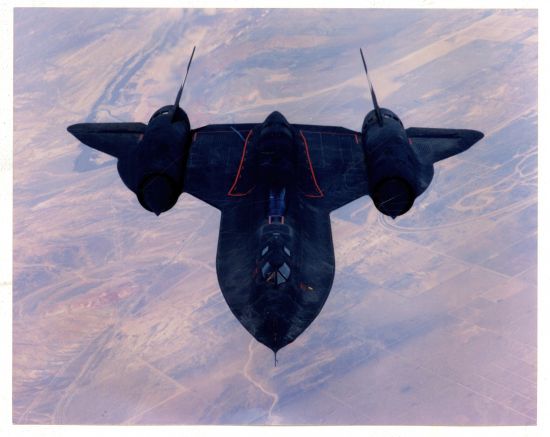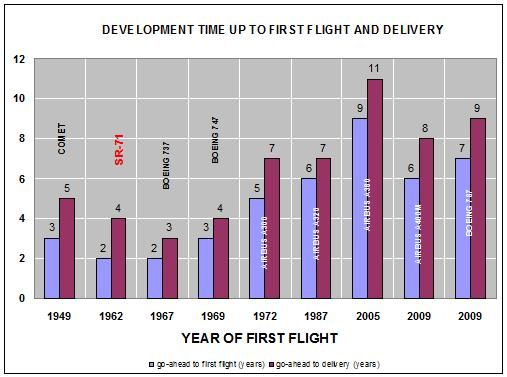THE FASTEST EVER AIRCRAFT
All aircraft enthusiasts and the ones that have been working in aerospace for decades know that the fastest ever is the Lockheed SR-71 Blackbird. It looks like a “Star wars” aircraft but it is what we can call a conventional aircraft, what means that it takes off and lands as any other aircraft. Some other aircraft could be faster, as the X-15, but they did not take off by themselves.
But why talk about the Blackbird, as it is not operational any more and can be seen only on aircraft museums? The reason is quite simple: working with the new generation of aerospace engineers and designers, exposed to the slogans of the aerospace giants of today (“high-technology”, “state-of-the art” engineering tools, “Next” and so on), few of these young professionals know that there was a period of the aerospace history when the things were done and well done, without all the “high-tech” tools available today. A period when engineers and designers were making aircraft (and also space ships) that would be impossible to be done today in the timeframe and cost of those magnificent engineering achievements. If you do not agree with our words, we will present data, at the end of the article, of the new designs of today and you may conclude by yourself

DEVELOPMENT
The SR-71 originated from a similar design that was the A-12. In the early 60’s the reconnaissance aircraft used by the USA (the U-2) was vulnerable due to its low speed, so that a new design for a faster reconnaissance aircraft was necessary. The contract for development of the A-12 (predecessor of the SR-71) was awarded to Lockheed in August 1959 and a contract for production of 12 aircraft followed on January 1960. The first flight was on April 1962. At this time the engines were P&W JT-75, as the JT-58, developed for the A-12/SR-71, were not fully operational. On January 1963 the aircraft was fitted with the P&W JT-58 and reached speeds in excess of Mach 3. It is important to note that from contract award to first flight it took 2 years and to fly at Mach 3 a little more.
The contract for production of the SR-71 was awarded to Lockheed on December 1962 and the first flight was on December 1964, just 2 years after. The engineer leading the Blackbird development was Clarence L. “Kelly” Johnson.
BASIC DATA AND PERFORMANCE
Even today there is no aircraft that could get close to the performance of the SR-71. It can fly at Mach 3.2 at 85,000ft with a range of 3,200 nautical miles (without refueling). The SR-71 settled on 1976 speed and altitude records (Altitude in Horizontal Flight: 85,068.997 ft – 25,929 m and Speed Over a Straight Course: 2,193.167 mph – 3,529.6 km/h), unbeaten up to now. The table below presents some basic data of the Blackbird. More information can be accessed with the links.


WHAT WAS NEW FOR THE BLACKBIRD
Reading the news today about recent developments and their delays, the most common excuse for the inability of today’s management to handle any development in time and cost is always about “new”. New materials, new manufacturing process, new systems, new software, new supply chain management and so on. For the SR-71 there were also “new” things and , in fact, almost everything was new and it was still developed in a short time. The main “new” things on the blackbird:
New engine – the P&W J-58 was a new engine that could operate for extended time at high Mach numbers with afterburner, It was developed for the A-12/SR-71 aircraft.
New fuel – due to the temperature op operation of the Blackbird, the J-58 engines used an special fuel. The JP-7 fuel has low volatility and is flash-resistant.
New structural material – Titanium, the basic material that the Blackbird is made of, was a new material at those days and the only available metal that could resist the high temperatures that the airframe was exposed on cruise flight. The main landing gear is up to today the largest titanium forget part use in aircraft.
New hydraulic fluids – also due to the operating temperature, hydraulic fluids had to be developed specifically for application on the aircraft.
New Aerodynamics – just looking at the aircraft, it is shaped for high speed, what was something completely new at those times. Even today it is still ahead of anything flying our skies.
New tires – the rubber compound of the tires was developed to resist high temperatures, having aluminium powder and filled with nitrogen (not a practice at those days).
Just not to extend too much, the crew escape system, the control of the engine spike with an analog computer and many other details were completely new. Even with all these “news”, it still had a development time of 2 years.
WHAT DID NOT EXIST DURING THE SR-71 DEVELOPMENT
Does not make any difference where you work today, you will have a PC and/or a workstation at your desk, connected to a network, and software for the type of engineering activity you work with. But how was it is the early 60’s?
Calculations were done with slide rules. Not even the simplest electronic hand calculator existed, so no calculators, no PC’s, no mainframes.
As there were no computers, structural analysis was done by what we now call “hand calculations”. No finite element models and calculations, no pre and post processors.
Drawings were real drawings, in paper, no drawing and design programs like CATIA and similar.
Aerodynamic calculations also using traditional calculations and testing, no CFD (Computational Fluid Dynamics) programs.
Manufacture of milled parts were done by workers without any numerical control machining.
Information inside the design office and communications with shop floor was with paper and telephone. No e-mails, conference calls, etc. Not even the fax machines existed at those days.
And, with all these “no’s”, it was still made in 2 years.
SOME DEVELOPMENT DATA
In order to position the incredible (at least for today’s companies) development time of the fastest ever aircraft, a table and a chart with the approximate development time for some known aircraft are presented below. Numbers are indicative only, as companies have teams that study new designs before official go-ahead. Note that some of these aircraft are with the “new” ingredient: Comet is the first pressurized airliner. The Boeing 747 is the first airliner to be equipped with a high by-pass turbo fan engine and high redundant systems. The A300 is the first twin engine wide body and incorporated composite parts (not common when it was designed). The A320 is the first commercial aircraft with flight-by-wire controls and side stick. The A400M is the first military transport to have extensive use of composite materials on wings and the Boeing 787 is the first airliner with composite wing and fuselage. So, all these designs have the “new”, but not at the extension of the Blackbird.

Note: Assuming that the A400M will be delivered on December 2011.

Note that most of these aircraft developments have the “new” ingredient: Comet is the first pressurized airliner. The Boeing 747 is the first airliner to be equipped with a high by-pass turbo fan engine and high redundant systems. The A300 is the first twin engine wide body and has many composite parts (not common when it was designed). The A320 is the first commercial aircraft with flight-by-wire controls and side stick. The A400M is the first military transport to have extensive use of composite materials on wings and the Boeing 787 is the first airliner with composite wing and fuselage. So, all these designs have the “new”, but not at the extension of the Blackbird.
CONCLUSION
The Blackbird will keep its records for a long time. Nothing compares with its capabilities and today, even with all tools available, a similar development will take what, 20 years? By the evolution of development times of new projects, maybe more. Industry today lost the track of doing the things focused, with chief designers like Kelly Johnson (A-12, SR-71, F-104) or Ed Heinemann (Skyraider, Skyhawk). The result is clear in all new developments: delays, technical problems and cost overrun. Some good examples: A380, A400M, Boeing 787, F-22, JSF, just to mention the well known.
TO KNOW MORE
Research for this article was done using many sources. The list of links here is just part of it. All them have additional information.
http://www.lockheedmartin.com/aboutus/history/SR71Blackbird.html
http://malith.8m.com/aircraft/71/ques.htm
http://www.flightglobal.com/airspace/media/historicalfarnboroughairshows/farnborough-air-show-sr-71-58827.aspx
http://www.rbogash.com/boeing_delay.html
http://www.rbogash.com/737early.html
http://www.wvi.com/%7Esr71webmaster/kelly1.htm
http://www.combataircraft.com/en/Military-Aircraft/Lockheed-Martin/SR-71ABlackbird/
http://www.sr-71.org/blackbird/sr-71/
Photos from:
http://www.flightglobal.com/airspace/media/default.aspx?mq=blackbird
http://www.military-today.com/aircraft/lockheed_sr71.htm
Engineer’s Tool Kit © – http://www.engineerstoolkit.com
Article written on October 2011. No restrictions for non commercial use as long not altered and referencing the source.
Disclaimer:
Engineer’s Tool Kit assumes no responsibility for the data presented in the article. Information is presented as is. Engineer’s Tool Kit is a non commercial website and material used here is in accordance with the Fair Usage Law. If any copyrighted material here is, by mistake, not in accordance with the Fair Usage Law, please contact for immediate removal.
http://www.linkedin.com/news?viewArticle=&articleID=831129420&gid=3461196&type=member&item=74691055&articleURL=http%3A%2F%2Fwww%2Eengineerstoolkit%2Enet%2Fthe-fastestest-ever-aircraft%2F&urlhash=tOOn&trk=group_most_popular-0-b-shrttl
No comments:
Post a Comment